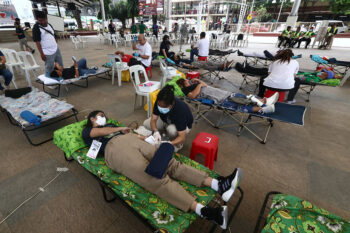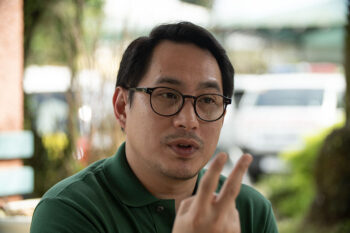GENERAL SANTOS CITY (MindaNews/2 Aug) – Communist rebels are again on the offensive, albeit in the less violent front.
Last week, rebel spokesman for Mindanao Jorge Madlos, more popularly known for his nom de guerre Ka Oris, gave an extensive interview to select members of the local media from Davao City, giving them exclusive shots, quotes and timely sound bytes just as the rest of the press and the nation were training their attention to President Benigno Aquino III who delivered his third State of the Nation Address (SONA).
Perhaps making up for the decision to skip their annual press conference in time for the 44th founding anniversary of the Communist Party of the Philippines (CPP) in December, Madlos made sure he brought to the attention that Aquino was wrong in ignoring the stalled peace process with the armed Left in the his SONA.
At the same time, the rebels are showing all and sundry that in certain parts of Eastern Mindanao, there exist two governments – theirs and the Philippine government – by increasing their capacity to hit at will vulnerable soft military targets without suffering major setbacks.
Madlos, the designated spokesman of the National Democratic Front (NDF), has lately become the face of the communist rebels following the death of iconic rebel figure Gregorio “Ka Roger” Rosal.
Almost simultaneously, a clandestine interview of Ka Simeon Santiago, political officer of the Medardo Arce Command of the New People’s Army of the Southern Mindanao Regional Party Committee of the CPP-NPA, was also posted and uploaded in the Facebook account of rebel propagandist Marco Valbuena, uncannily titled Bagong Gobyerno sa Timog Mindanao (New Government in Southern Mindanao). From the video clips of the interview, it was obvious these were taken just at the outskirts of the city.
These were separate propaganda offensives but their timing suggests these are coordinated and part of a broader attempt to reach a wider audience and for obvious agenda.
Peace talks
Madlos has never been coy about their assessment of the Aquino government although the rebels have repeatedly supported calls for the resumption of the peace talks.
“For the NPA (New People’s Army), CPP (Communist Party of the Philippines) and NDF, we are very much willing to continue the peace talks. And we will exert all efforts so that the peace negotiations can prosper,” Madlos assured.
Previous statements from Madlos coupled with seeming lack of enthusiasm from the Aquino government, however, point to an increasing pessimism over the direction of the peace negotiations between the Philippine government (GPH) and the NDF.
Over the last 26 years, the CPP-NPA-NDF have engaged the government in on-and-off again peace negotiations. Except for a brief period – immediately after the 1986 EDSA revolt – the communists have rejected all calls for an immediate cessation of hostilities as a precondition to the full resumption of the peace negotiations.
The rebels see the Aquino peace tact as no more than a pacifist surrender of the communist rebels.
“He is not at all interested in serious peace negotiations but only in demanding the surrender and pacification of the revolutionary forces and people,” said Fidel Agcaoili, spokesman of the Netherlands-based NDF peace talks negotiating panel.
The fact that the Office of the Presidential Assistant for the Peace Process has to conduct a survey via its Twitter account #tellOPAPP asking readers whether “meaningful discussions toward the resumption of formal talks” should at all be a considered a welcome development only reveals the government’s ambivalent and cavalier attitude towards the peace talks with the NDF.
The last statement posted in the OPAPP website with reference to the GRP-NDFP peace talks was in June, which said it agreed “to meet the NDF informally to tackle the issues and concerns that have caused an impasse in the peace negotiations since February 2011.”
In contrast, a separate survey shows a different approach towards the GRP’s peace negotiations with the Moro Islamic Liberation Front (MILF) when OPPAP asked if the readers are optimistic a peace pact can be forged with the Moro rebels this year.
While Aquino broke protocol by agreeing to meet with MILF’s Murad al Haj Ibrahim in Tokyo last year, his negotiating panel has adamantly rejected NDF demands to release the latter’s detained rebel consultants, jeopardizing efforts to revive the peace process.
The increased accessibility of the rebels to the media can only be viewed as a reminder that the CPP-NPA-NDF is a pesky lot that any Philippine government will have to deal with.
Elections and organs of political power
More importantly, the 2013 elections could also be the underlying objective of recent increased media presence of communist rebels.
In December 2009, several candidates for local elective posts throughout Mindanao were seen gracing the 41st founding anniversary of the CPP. Four years earlier, a senatorial aspirant reportedly joined the beeline in seeking audience with the NDF in Mindanao. So did a candidate for governor in one of the western provinces of Mindanao who eventually won in 2007.
When Ka Simeon Santiago said a “people’s government” now exists in some parts of eastern Mindanao, these were not only issued to boost the morale of communists rebels and their supporters. It is also a veiled message to politicians eying seats in the local government that they may have to deal with the rebels to again gain access to voters in the countryside. For the CPP-NPA-NDF, this is not just a political statement but also one way of raising rebel funds.
Between 1996 and 2007, the NDF rebels was said to have raised P1.15 billion (US$27 million) from “permit-to-campaign taxes.”
A top military official in Mindanao said the NPAs are intimidating politicians into submitting to the “extortion activities” of the rebels.
“They (NPAs) have even resorted into issuing ‘permits-to-win’ in other areas as if to guarantee victory to some politicians,” said Lt. Gen. Jorge Segovia, commanding general of the AFP’s Eastern Mindanao Command.
Segovia however could not provide intelligence information on how much the rebels were able to raise from their PTCs in the 2010 elections.
Ka Simeon said they have established organs of political power in various levels and is believed to have at least a town-level shadow government in some parts of the island where they operate, with their own taxation and “rebel justice” systems.
In private, though, the military has admitted to the increased rebel strength in the eastern and central areas of Mindanao, according to a source who was invited to one of closed-door military briefings.
The NPA raid of Taganito Mines and two other Sumitomo-owned mining companies, which destroyed more than half a billion pesos (US$12 million) worth of equipment and properties without inflicting a single casualty, is too daring to ignore.
With over 32 guerrilla fronts in the island, the NPAs in Mindanao are said to be the strongest throughout the country with at least half of its total armed strength scattered all over the Mindanao main island.
Again, the Davao and Caraga regions are where the rebels are at their strongest strength despite repeatedly downplaying of their capabilities by the military.
Mining
Incidentally, it is also in the Caraga region (Agusan and Surigao provinces) where most mining firms already operating are located.
Logging operations used to be the rich supply of rebel funds but with diminishing forests and renewed anti-logging campaign, the rebels have turned into mining as primary revenue source. In contrast with the Aquino government, the rebels appear to be more accommodating to small scale mining operations than large commercial mining companies.
Madlos said mining has replaced logging as the top “destroyer” of the environment in Mindanao and they have issued veiled and direct threats against operations of large scale mining companies in the island.
The Aquino government however considers mining as key to economic development in the country and wants bigger share in the revenues and taxes as a matter of policy while regulating and restricting small scale miners in government designated areas.
Old habits die hard
Segovia however said the NPAs are just covering up losses in the battlefield by conducting series of media interviews.
“These are designed to boost the morale of their fighters to cover up atrocities they are committing against the lumads (indigenous tribes),” Segovia said in a phone interview.
Late last month, NPA guerillas waylaid tribal leader Cawsing Ogaw whom they accused of working for the military in a rebel checkpoint in Marilog district, Davao City. A separate NPA unit also ambushed and killed paramilitary leader Abantas Ansabo alias Kumander Ibon whom the rebels accused of killing at least 19 peasants and lumad supporters in Arakan, Cotabato. Both killings happened on the same day, July 27.
These, according to Segovia, have alienated the NPAs who he claimed have become more and more dogmatic.
“Old habits die hard. This (dogmatism) will be the cause of their downfall,” he said.
Despite increased armed rebel activities which included a raid at a mining firm in Agusan del Sur which netted 17 high powered rifles for the NPAs, Segovia said the NPAs in his area of responsibility are down to less than 1,500 and belied claims the rebels are gaining strength (the Eastern Mindanao Command of the AFP covers the Socsksargen, Davao, Caraga and Central Mindanao regions).
“They have suffered heavy losses nationwide that is why it is giving an impression they are getting stronger in eastern Mindanao,” Segovia explained.
(MindaViews is the opinion section of MindaNews. Edwin Espejo writes for the asiancorrespondent.com.)







